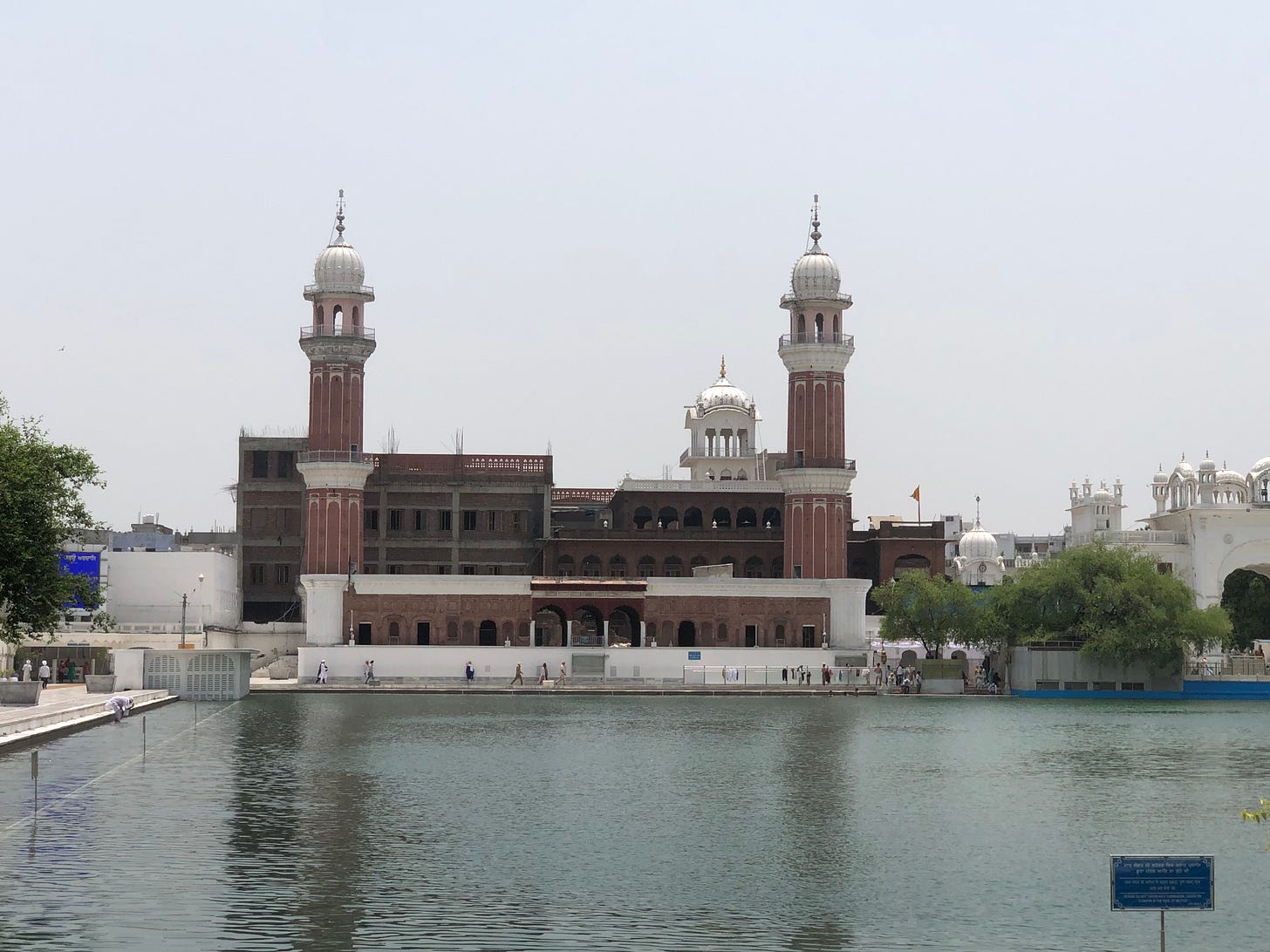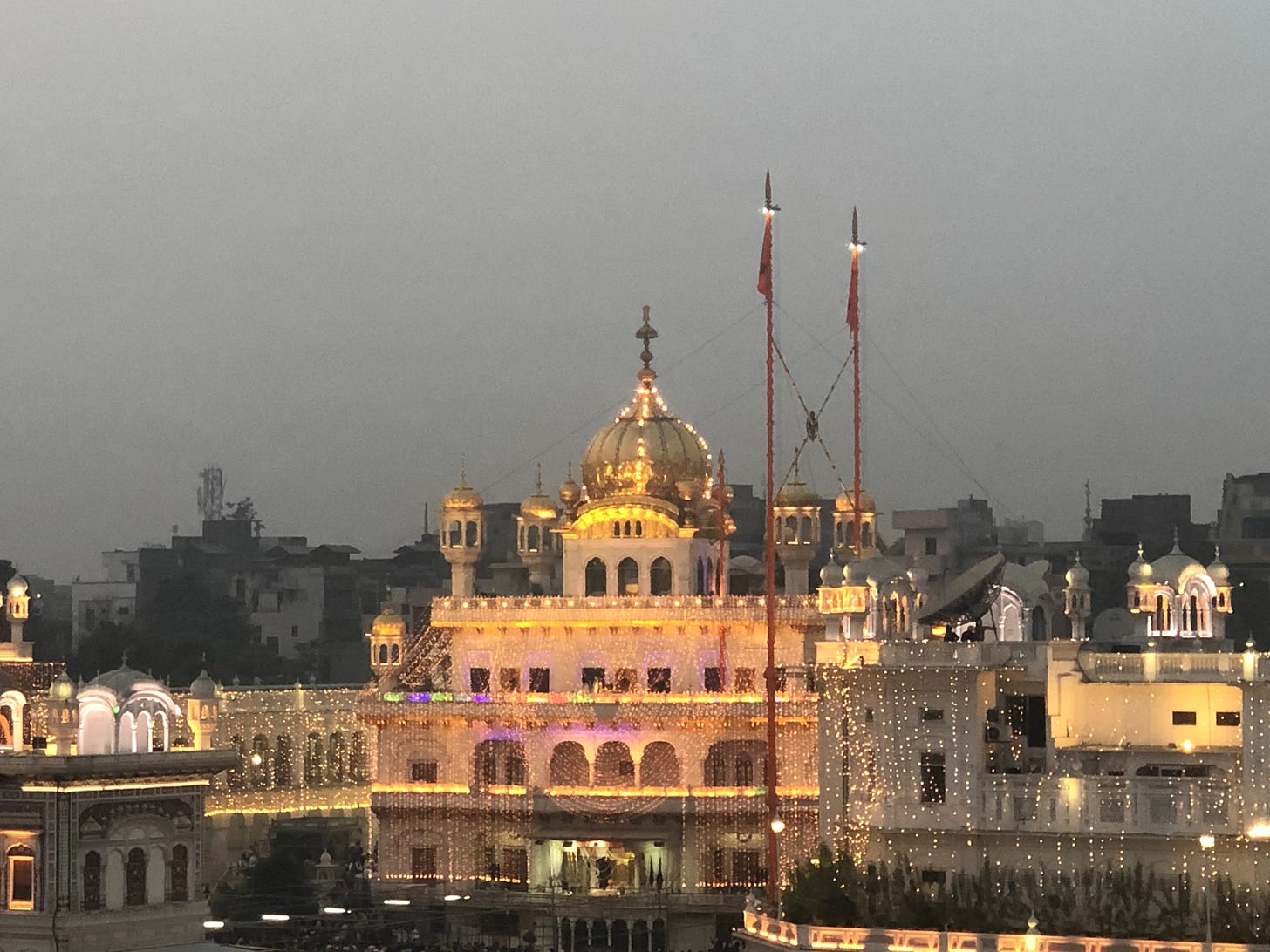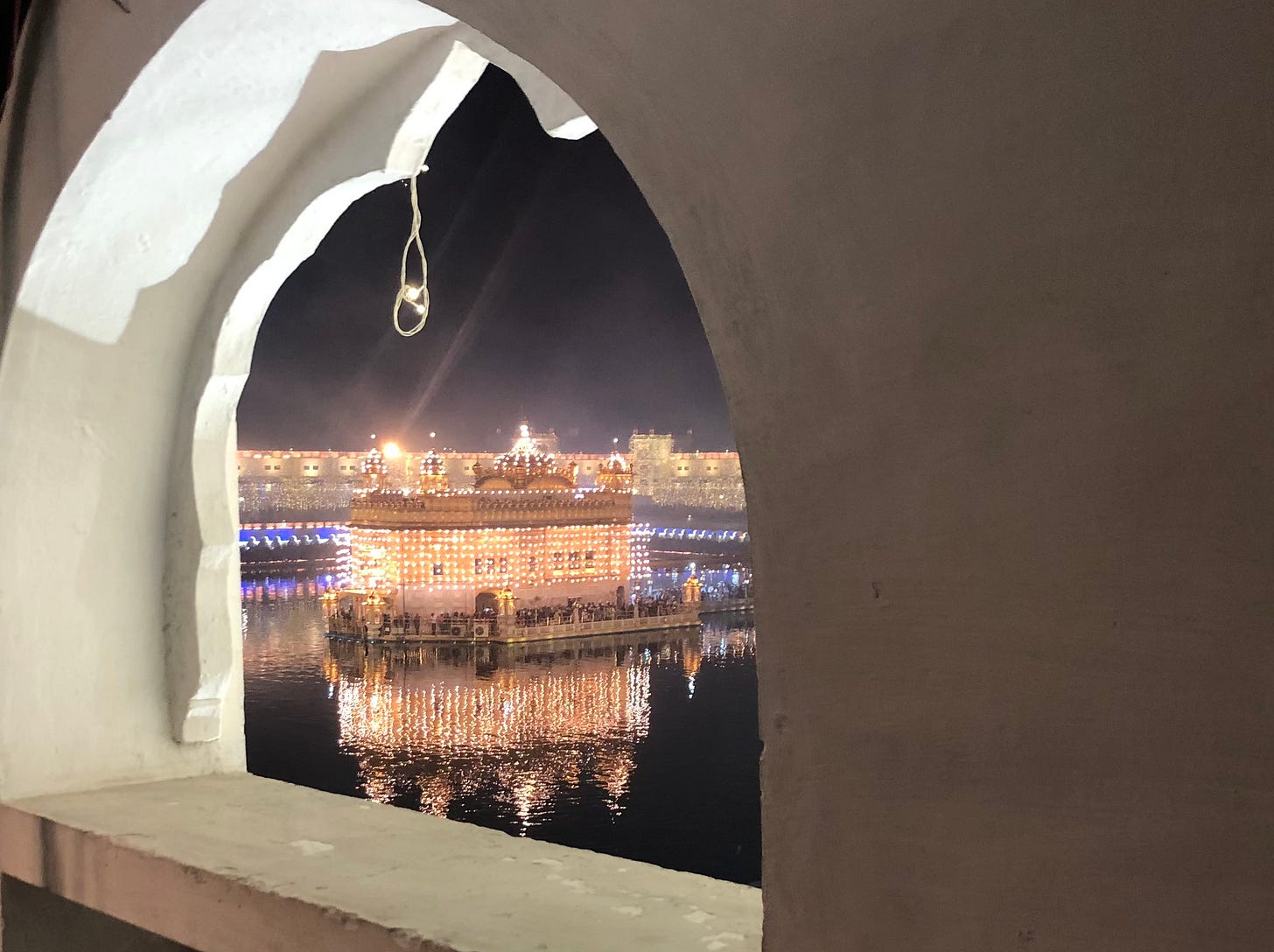Maghar Sangrand (ਮੱਘਰ ਸੰਗਰਾਂਦ): Unveiling the Spiritual Depth of Bārah Māhā
Bārah Māhā (ਬਾਰਹ ਮਾਹਾ) & the Spiritual Quest in the month of Maghar (ਮੱਘਰ).
Bārah Māhā and the Reflections of Maghar
Understanding Bārah Māhā
Bārah Māhā (ਬਾਰਹ ਮਾਹਾ), a spiritual masterpiece by Sri Guru Arjan Dev Ji, holds a revered place in the Sri Guru Granth Sahib, spanning Angs 133 to 135. This sacred scripture acts as a celestial compass through the year, offering profound insights into the soul's odyssey across the changing seasons. Each month is beautifully encapsulated with distinct spiritual themes, mirroring the myriad emotional and spiritual states of the human soul.
In eloquent and metaphorical language, Guru Sahib initially portrays how human beings, symbolized as the soul-bride, often become estranged from the Divine, the Almighty God or Akaal Purakh, amidst the rigors of daily life. The Bārah Māhā paath emerges as more than just a poetic expression; it is a spiritual roadmap, guiding the human soul towards reestablishing a sacred connection with the Divine Creator in every month of the year. This text is a beacon for all seekers, illuminating the path to divine communion through the ebb and flow of life’s seasons.
Maghar: A Time for Introspection
As we transition into Maghar (ਮੱਘਰ) on the 16th of November, a significant time in both the Indian and Nanakshahi Sikh calendars, we embrace a phase of deep introspection and spiritual awakening. Maghar, following the reflective essence of Kartik (ਕੱਤਕ), brings about an inward journey, symbolized by the colder air and nature's serene transformation. This period is much more than a mere change of seasons; it's a time for heightened spiritual contemplation and connection.
The Soul's Path in Maghar as per Bārah Māhā
In the verses dedicated to Maghar in Bārah Māhā, the human soul is depicted as a bride in an eternal quest for unity with the Divine. This month encourages a deeper exploration of the self, confronting the ego, and fostering a stronger bond with the Divine. As Maghar's distinct chill sets in, the verses guide us through a metaphorical journey of the soul, seeking enlightenment amidst life's challenges. The teachings within these verses of Maghar provide both solace and direction, encouraging a profound understanding that transcends their literal interpretation, touching our hearts with reverence and a deeper spiritual essence.
Dive into the spiritual depths of Bārah Māhā (ਬਾਰਹ ਮਾਹਾ) as Guru Arjan Dev Ji reveals the emotional and spiritual states experienced by seekers during this introspective month.
In Maghar: The Divine Dance of Contemplation and Longing
ਮੰਘਿਰਿ ਮਾਹਿ ਸੋਹੰਦੀਆ ਹਰਿ ਪਿਰ ਸੰਗਿ ਬੈਠੜੀਆਹ ॥ "In the month of Maghar, truly beautiful are those those who sit beside their Beloved Husband Lord."
ਤਿਨ ਕੀ ਸੋਭਾ ਕਿਆ ਗਣੀ ਜਿ ਸਾਹਿਬਿ ਮੇਲੜੀਆਹ ॥ "The glory of those who blend with their Lord and Master is truly immeasurable."
ਤਨੁ ਮਨੁ ਮਉਲਿਆ ਰਾਮ ਸਿਉ ਸੰਗਿ ਸਾਧ ਸਹੇਲੜੀਆਹ ॥ "Their bodies and minds blossom forth in the Lord; they have the companionship of the Holy Saints."
ਸਾਧ ਜਨਾ ਤੇ ਬਾਹਰੀ ਸੇ ਰਹਨਿ ਇਕੇਲੜੀਆਹ ॥ "Those who lack the Company of the Holy, remain all alone."
ਤਿਨ ਦੁਖੁ ਨ ਕਬਹੂ ਉਤਰੈ ਸੇ ਜਮ ਕੈ ਵਸਿ ਪੜੀਆਹ ॥ "Their pain never departs, and they fall into the grip of the Messenger of Death."
ਜਿਨੀ ਰਾਵਿਆ ਪ੍ਰਭੁ ਆਪਣਾ ਸੇ ਦਿਸਨਿ ਨਿਤ ਖੜੀਆਹ ॥ "Those who have ravished and enjoyed their God, are seen to be continually exalted and uplifted."
ਰਤਨ ਜਵੇਹਰ ਲਾਲ ਹਰਿ ਕੰਠਿ ਤਿਨਾ ਜੜੀਆਹ ॥ "They wear the Necklace of the jewels, emeralds and rubies of the Lord's Name."
ਨਾਨਕ ਬਾਂਛੈ ਧੂੜਿ ਤਿਨ ਪ੍ਰਭ ਸਰਣੀ ਦਰਿ ਪੜੀਆਹ ॥ "Nanak seeks the dust of the feet of those who take to the Sanctuary of the Lord's Door."
ਮੰਘਿਰਿ ਪ੍ਰਭੁ ਆਰਾਧਣਾ ਬਹੁੜਿ ਨ ਜਨਮੜੀਆਹ ॥੧੦॥ "Those who worship and contemplate upon God in Maghar, do not suffer the cycle of reincarnation ever again. ||10||"
These verses encapsulate the essence of spiritual seeking and divine communion in the month of Maghar, as illustrated in the Bārah Māhā.
As we reach the culmination of Maghar's verses, our journey through this spiritually profound month has traversed a landscape rich in introspection and spiritual longing. The teachings of Guru Sahib during Maghar highlight the importance of self-reflection, deepening our devotion, and maintaining a strong connection with the Divine. With the arrival of Maghar, we experience the brisk onset of early winter, signaling the end of autumn's tranquility. This transition invites our souls to find a balance between meditative stillness and a warm, devout embrace of the Divine. In the midst of winter's reflective calm, let our spirits remain passionately committed to seeking the Divine.
Let the wisdom imparted in Maghar guide us as we continue our eternal quest for spiritual enlightenment.

Placing in the broader context of Bārah Māhā paath.
To provide a more comprehensive understanding of the above verses dedicated to Maghar, it is essential to contextualize them within the broader framework of the Bārah Māhā paath. This sacred text begins with a profound exploration of how our actions and entanglements in the material world often lead to a sense of estrangement from the Divine. It paints a vivid picture of the human soul, embroiled in worldly concerns, drifting away from its spiritual anchor.
Each month in the Bārah Māhā is presented as a unique chapter in the soul's terrestrial journey, offering distinct opportunities for spiritual reconnection and growth. The human soul is poetically personified as a bride, longing for union with the omniscient, omnipresent God. This allegory beautifully encapsulates the soul's yearning for divine communion, highlighting the cyclical nature of spiritual opportunities that each month brings.
As we delved into the verses of Maghar, we were reminded of this ongoing journey. The soul, having navigated through various stages of detachment and enlightenment throughout the year, finds in Maghar a profound moment for introspection and reconnection. The cold embrace of winter in Maghar symbolizes a period of going inward, reflecting on one's actions and their spiritual repercussions, and seeking a path to reunite with the Divine.
Thus, understanding the opening lines of the Bārah Māhā is crucial. They set the stage for a deeper appreciation of the verses of Maghar, as they elucidate the narrative of the soul's quest for divine unity amid the distractions and challenges of the earthly existence.
ਕਿਰਤਿ ਕਰਮ ਕੇ ਵਿਚੁੜੇ ਕਿਰ ਕਿਰਪਾ ਮੇਲਹੁ ਰਾਮ ॥: Due to our actions and destiny, we are separated from the Lord. O Lord, through Your grace, unite us with Yourself.
ਚਾਰਿ ਕੁੰਟ ਦਹ ਦਿਸ ਭ੍ਰਮੇ ਥਕਿ ਆਏ ਪ੍ਰਭ ਕੀ ਸਾਮ ॥: Wandering in all four corners and ten directions, tired, we come to the shelter of the Lord.
ਧੇਨੁ ਦੁਧਿ ਤੇ ਬਾਹਰੀ ਕਿਤੈ ਨ ਆਵੈ ਕਾਮ ॥: Just as a cow is of no use without milk, similarly...
ਜਲ ਬਿਨੁ ਸਾਖ ਕੁਮਲਾਵਤੀ ਉਪਜੈ ਨਾਹੀ ਦਾਮ ॥: ...like a plant wilting without water, it does not flourish.
ਹਰਿ ਨਾਹ ਨ ਮਿਲੀਐ ਸਾਜਨੈ ਕਤ ਪਾਈਐ ਬਿਸਰਾਮ ॥: Without uniting with the Lord, O Friend, where can we find true peace?
ਜਿਤੁ ਘਰਿ ਹਰਿ ਕੰਤੁ ਨ ਪ੍ਰਗਟਈ ਭਠਿ ਨਗਰ ਸੇ ਗਰਾਮ ॥: In that house (or heart) where the Lord does not manifest, even a palace feels like a deserted village.
ਸਰਬ ਸੀਗਾਰ ਤੰਬੋਲ ਰਸ ਸੰਗੁ ਦੇਹੀ ਸਭ ਖਾਮ ॥: All adornments, enjoyments, and bodily pleasures are in vain...
ਪ੍ਰਭੁ ਸੁਆਮੀ ਕੰਤ ਵਿਹੂਣੀਆ ਮੀਤ ਸਜਣ ਸਿਭ ਜਾਮ ॥: ...without the Lord Master; without our Divine Beloved, everything is like a deadly poison.
ਨਾਨਕ ਕੀ ਬੇਨੰਤੀਆ ਕਿਰ ਕਿਰਪਾ ਦੀਜੈ ਨਾਮ ॥: Nanak pleads, bestow Your grace and bless us with Your Divine Name.
ਹਰਿ ਮੇਲਹੁ ਸੁਆਮੀ ਸੰਗਿ ਪ੍ਰਭੁ ਜਿਸ ਕਾ ਨਿਹਚਲ ਧਾਮ ॥੧॥: Unite us with You, O Lord, the Eternal Abode.
Each month offers a unique opportunity
Venturing through the spiritual terrains crafted by Guru Arjan Dev Ji, we've witnessed the soul, represented as a soul-bride, in her unyielding quest for Divine union. This ceaseless dance of detachment from the worldly and the pull towards the spiritual acts as a potent reminder of the transient nature of earthly pleasures compared to the eternal glow of Divine love. The recurring motif of seeking Guru Ji's grace emerges as a central spiritual directive and the foundation of our spiritual journey.
With this spiritual compass in hand, as we find ourselves on the cusp of Maghar, those spiritual seekers yearning for a comprehensive view of the entire Bārah Māhā (ਬਾਰਹ ਮਾਹਾ) text will benefit greatly from the succinct yet insightful narratives of each month. For a deeper exploration of the unique spiritual essence embodied within every month as described in the Bārah Māhā, readers are encouraged to refer to the detailed footnotes provided. These annotations offer valuable insights, enhancing the understanding of the text’s rich tapestry of spiritual wisdom.
Every Moment: Illuminated by Divine Grace
As Guru Arjan Dev Ji leads us through the verses for Maghar, a clear message emerges, highlighting the constant presence of divine moments in our lives. Maghar, with its distinctive atmosphere and the onset of winter, creates a unique spiritual setting that aligns with our emotions and aspirations. However, Guru Sahib emphasizes that true spirituality goes beyond these seasonal changes. Every heartbeat and breath during Maghar, as with all months, can embody a divine embrace if we align our spirits accordingly. The shift into winter that Maghar brings is not just a mark on the calendar but a symbol of life's dynamic journey, with each moment presenting an opportunity for connection with the Divine.
No particular moment in Maghar, or in any month, is designated as exclusively auspicious for divine meditation, seeking Guru's wisdom, or engaging in spiritual communion. Instead, every instant in Maghar can become a pathway to divine connection when met with heartfelt love, unwavering devotion, and sincere intent. Those fortunate souls who receive God's grace find every moment of Maghar filled with deep spiritual meaning. Steadfast in their faith and undistracted by worldly concerns, they understand that the true journey towards spiritual enlightenment transcends temporal constraints and is deeply rooted in a continuous devotion to the Divine.
ਜਿਨਿ ਜਿਨਿ ਨਾਮੁ ਧਿਆਇਆ ਤਿਨ ਕੇ ਕਾਜ ਸਰੇ ॥ Those who meditate on the Divine Name, their tasks are fulfilled.
ਹਰਿ ਗੁਰੁ ਪੂਰਾ ਆਰਾਧਿਆ ਦਰਗਹ ਸਚਿ ਖਰੇ ॥ Those who worship the perfect Guru and Lord, stand true in the divine court.
ਸਰਬ ਸੁਖਾ ਨਿਧਿ ਚਰਣ ਹਰਿ ਭਉਜਲੁ ਬਿਖਮੁ ਤਰੇ ॥ All comforts are in the Lord's feet; they cross the treacherous world-ocean.
ਪ੍ਰੇਮ ਭਗਤਿ ਤਿਨ ਪਾਈਆ ਬਿਖਿਆ ਨਾਹਿ ਜਰੇ ॥ They attain love and devotion, and worldly temptations don't affect them.
ਕੂੜ ਗਏ ਦੁਬਿਧਾ ਨਸੀ ਪੂਰਨ ਸਚਿ ਭਰੇ ॥ Falsehood departs, duality is dispelled, and they are filled with the complete Truth.
ਪਾਰਬ੍ਰਹਮੁ ਪ੍ਰਭੁ ਸੇਵਦੇ ਮਨ ਅੰਦਰਿ ਏਕੁ ਧਰੇ ॥ They serve the Supreme Lord and enshrine the One God within their hearts.
ਮਾਹ ਦਿਵਸ ਮੂਰਤ ਭਲੇ ਜਿਸ ਕਉ ਨਦਰਿ ਕਰੇ ॥ Every month, day, and moment is auspicious for those upon whom He casts His Glance of Grace.
ਨਾਨਕੁ ਮੰਗੈ ਦਰਸ ਦਾਨੁ ਕਿਰਪਾ ਕਰਹੁ ਹਰੇ ॥14॥1॥ Nanak begs for the gift of divine vision; O Lord, shower Your Grace.
The Timeless Spiritual Union: Transcending Celestial Cycles
In the concluding verses, Guru Arjan Dev Ji reveals a central tenet that acts as the cornerstone of spiritual evolution. Moving beyond the prevalent cultural emphasis on astrologically auspicious moments, he accentuates that genuine spiritual moments are not determined by starry configurations but by the encompassing Grace of the Divine. As Guru Sahib elucidates, each tick of the clock is sacred—whether day or night, regardless of the month or season—when illuminated by the benevolent embrace of the Divine. This isn't a deviation from the preceding verses; it's a profound reaffirmation of their intrinsic message: every fleeting moment is imbued with the potential for spiritual ascension and divine communion.
Guru Ji's earnest prayer, "Nanak craves the gift of divine vision; O Lord, shower Your Grace," stands as a heartfelt reminder for all of humanity. It underscores the essence of actively yearning for that Divine connection, rather than idly awaiting a so-called 'auspicious' time. This fervent call inspires every seeker to cherish each passing moment, perceiving each juncture as a 'shub karaj'—a propitious occasion for noble endeavors. At its core, this is the epitome of a life infused with spiritual consciousness, where the mundane is elevated to the divine, not by celestial orchestration, but through the soul's harmonious alignment with the vast infinite.
Reflecting and Looking Forward
In the intricate tapestry of existence, each individual strand—every fleeting instance—holds the potential to radiate with divine luminescence. It isn't the celestial alignments that sanctify a moment, but the sanctum within our hearts, illuminated by unwavering faith and reverence.1
ਵਾਹਿਗੁਰੂ ਜੀ ਕਾ ਖਾਲਸਾ,
ਵਾਹਿਗੁਰੂ ਜੀ ਕੀ ਫਤਿਹ।
Evolving Emotions of the Soul: Twelve Months of Yearning and Devotion
Guided by the luminous teachings of Guru Arjan Dev Ji, we recognize that each month in the Nanakshahi calendar carries a profound spiritual message. The changing landscapes of nature, resonating with the ebb and flow of our inner emotions, set the stage for understanding this divine journey.
Chet (ਚੇਤ) (March-April): The month signifies the renewal of life. The human soul laments forgetting the Divine and its longing intensifies.
Vaisakh (ਵੈਸਾਖ) (April-May): As nature blooms, there's an analogy to the blossoming love for God, but the soul remains restless without the beloved.
Jeth (ਜੇਠ) (May-June): The hottest month signifies the burning desire of the soul for the Divine.
Harh (ਹਾੜ) (June-July): Despite the outpour of rain, without the beloved, everything seems insipid.
Sawan (ਸਾਵਣ) (July-August): Known for heavy rains; the soul thirsts for the Divine like the parched earth thirsts for rain.
Bhadon (ਭਾਦੋਂ) (August-September): The soul expresses the pain of separation and yearns for reunion.
Assu (ਅੱਸੂ) (September-October): The soul finds solace in singing praises of the Divine.
Kartik (ਕੱਤਕ) (October-November): Without God's grace, life feels barren, similar to a forest without its foliage.
Maghar (ਮੱਘਰ) (November-December): The chilling winds signify the coldness one feels in the absence of the Divine.
Poh (ਪੋਹ) (December-January): The winter month signifies the detachment of the soul without the Divine embrace.
Magh (ਮਾਘ) (January-February): The soul aspires to purify itself through selfless service and unwavering devotion.
Phagun (ਫੱਗਣ) (February-March): Spring arrives, yet without the beloved, the vibrancy seems muted.
Thus, the cyclical progression of months, as delineated by Guru Arjan Dev Ji, encapsulates the myriad hues of the soul's relationship with the Divine. Each month offers a reflection, a contemplation, and an opportunity for spiritual ascent. As we transition into the month of Maghar, let us keep this broader canvas in mind, enriching our understanding of the Guru's profound teachings.











……..this article is a divine Prasad..!!
Gurbani is a divine work of our Gurus. Guru Arjan Dev ji, in small age of 40s, wrote not only some 40% of SGGS, but also arranged the works of previous 4 Gurus, arranged them according to Ragas.
Unfortunate that English translation has completely ruined the context and intent of Gurus. In the translation in your article, "Lord" is the meaning of "Ram", "Prabhu", "Hari", and "Hare". "Supreme Lord" is the meaning of "Parbrahm", and "Yam" has been translated "Messanger of Death". Surprisingly, "Guru" has been translated as "Guru" only.
I hope, someday, in our life times, we can see accurate translation of SGGS, so that we all can see what our Gurus wanted us to understand, and what our scholars are feeding us.
Playing with Gurus' words is possibly the reason why our Panth is declining.